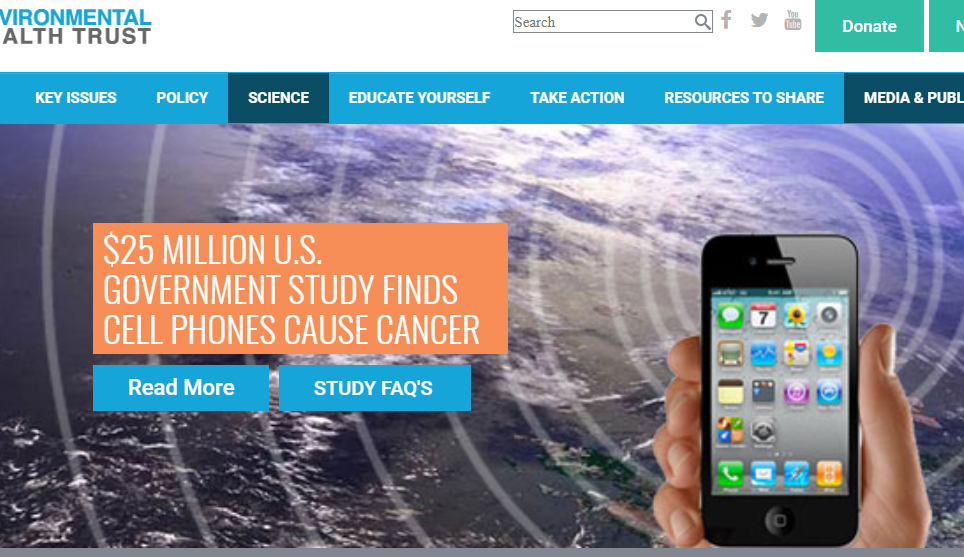If you’ve tried to research something online in the last few years, you may have come away with more questions than answers when all was said and done. Competing news articles, blogs, Facebook groups, and seemingly genuine sites all produce enough conflicting information to make anyone’s head spin. At this very moment, there’s a firehose of intentionally false content out there, and it’s gotten to the point where it’s near-impossible to find truth from fiction in certain instances. This is happening in part because of fake-grassroots (called astroturf) organizations and unwitting signal-boosters.
Unfortunately, there’s currently a well-funded effort to cast doubt on the safety of wireless tech (Bluetooth, cellphones, Wi-Fi) in particular. Let’s talk about it.
Genesis of a monster
If you want to know more about something, chances are your first stops are Google or Siri. Non-experts often ask search engines questions that would never occur to an expert, creating a search value for the answer to those questions. When a new search happens, search engines have to populate a list of sites addressing the question, but they can’t determine if the content is relevant until people click around on results. The articles that get clicks are usually the scariest ones, making topics without reputable data (data voids) sensationalist by nature.
Consequently, a combination of fake grassroots organizations (astroturfers) and profiteers tend to fill these data voids simply because it’s very easy to capture the top results for these valuable terms in the absence of real information. As the claims they peddle are usually shocking, scare articles tend to go viral by word of mouth or social media. Experts tend not to tackle these issues, not wanting to give the impression they’re even worthy of discussion. Clearly this approach isn’t working.
Sometimes the end result of these astroturfing efforts isn’t very harmful, but we’ve seen tragic outcomes with anti-vaccine scare campaigns, global warming denial, multi-level marketing (MLM) schemes, and even the 2016 U.S. election. Data voids are harmful because they provide an opportunity for bad actors to take advantage of people simply wanting to learn more about a subject, presumably because it might affect them directly. It’s not pleasant to think about, but the people who fill these voids with misinformation can put innocent people in harm’s way, all to earn a buck (or, y’know, destabilize the West).
For the last ten years, a handful of well-funded misinformation campaigns have been underway online and in print about the dangers of non-ionizing radio frequency electromagnetic radiation (RF EMR). Through a combination of money, concerned non-experts, and an absence of fact checking, the cause has been championed to the point where mainstream media, local governments, and countless people have been duped into accepting an obvious falsehood as truth — namely that Bluetooth, cellphones, and Wi-Fi are somehow the culprit behind (nonexistent) increased rates of cancer, depression, DNA damage, infertility, ADHD and autism.
Follow the money
If you search “is Bluetooth harmful” online, you’ll find almost nothing but misinformation — including that very bad CNN article on the front page. Bluetooth is a good example because it’s so extreme and obviously false, so someone campaigning on the issue should stick out like a sore thumb. If you scratch a little deeper, you’ll see organizations like the Environmental Health Trust pop up over and over again.
If you read the poorly fact-checked CNN article, much of the basis for the extremely questionable expert testimony rests with a 2016 National Toxicology Program study, and a nonprofit group with a seemingly-competent collection of experts at the helm. However, it’s a thin veneer covering a mountain of bullshit—and money.
Before I go any further, you should check out the companion piece we did covering the science of the supposed health risks of RF EMR. Additionally, the lead author of the study most often used to justify scaremongering gave a great summary of the findings, speaking with the Associated Press:
The evidence for an association between cellphones and cancer is weak. And so far, we have not seen a higher cancer risk in people… At best it might be a weak carcinogen … if in fact it is a carcinogen” —John Bucher, National Institute of Environmental Health Sciences
When I started looking into each of the doctors championing bizarre “science” for these supposed grassroots groups, I found most had a pattern of supporting debunked or flawed studies, and others simply misrepresented data with scary-sounding rhetoric. Some even claimed links between their issue of the day and poorly-understood disorders like autism (ASD). I shouldn’t need to point out this is a common tactic for those in other scare efforts like the anti-vaccine and anti-GMO crowd. However, it’s more than a little curious that someone would make these same claims over and over again without scientific consensus behind them.
Many of their arguments center around the common “think of the children!” appeal, kindling the false hope that somehow turning off the Wi-Fi at night will prevent little Billy’s hyperactive behavior. Of course, these claims all come with a disclaimer they don’t constitute medical advice, despite the inherent implications of a medical professional telling you what’s safe and what isn’t.
Even if you read into the studies and literature reviews showing equivocal evidence of cancer, science doesn’t work by one study finding something and establishing objective truth. You need lots and lots and lots of people performing studies on the same issues and mountains of evidence to prove a claim. Since a scientific consensus on a potential health risk posed by RF EMR doesn’t exist after almost 60 years of wireless tech studies, it’s safe to say the likelihood we’ve somehow missed the link between it and cancer is extremely low.
So, I started looking up tax returns. As luck would have it, I found a few threads to pull.
Turns out, much of the anti-cellphone scare effort (including the aforementioned EHT) was at one point partially-funded or directed by one particularly wealthy doctor, Dr. Lucy Waletzky, out of New York. Given that she’s been the Chair for the New York State Council of Parks, Recreation and Historic Preservation since 2007, (and therefore extremely busy) it did not surprise me that my attempts to get a comment for the story went unanswered.
Grassroots Environmental Education, a non profit Waletzky was listed as directing in 2016, even runs a few ancillary sites for signal boosting the message to other groups. A site called the BabySafe Project tells prospective parents about the alleged prenatal dangers of wireless radiation, and the ChildSafe School implores schools to limit child exposure to wireless radiation. Another wraps anti-wireless cautions into a book aimed toward helping parents care for sick kids.
Of course, these claims all come with a disclaimer that their advice to avoid wireless tech doesn't constitute medical advice, despite the implications inherent by a medical professional's input.
It’s entirely possible the people behind these groups genuinely believe what they’re doing is right. It’s entirely possible they’ve known someone with an acoustic neuroma or schwannoma and wanted to seek solace in action against what they believe to be the culprit. However, paying to fund a campaign against something when you don’t know it’s to blame is putting the cart before the horse.
Considering a majority of studies often touted as proof of the dangers of wireless radiation are either inconclusive or simply willfully misread, it’s hard to believe these groups have a deep respect for science guiding their actions. While it’s always good to verify what you think you know with studies, acting without a clear understanding of the issue can lead to unintended — or unforeseen — consequences.
Particularly disturbing, some of these sites play into the conspiracy-theory blog and Facebook-share crowd, much like the anti-vaccine movement does. When a site run by a nonprofit provides scare memes and repackages bland statements from legitimate medical groups to push a phony call to action or reason for panic, that’s a giant red flag. It also makes it prime material for Russian bots.
RT @TheDailySheeple: California Department of Public Health Hid This Warning on Cell Phone Radiation for Years
—_nickluna_, confirmed Bot
Digging through a now-outdated database of fake tweets, I was only able to find a handful of anti-cellphone posts or anti-Wi-Fi propaganda. However, the anti-U.S. social media effort is centered around generating as much controversy as possible regardless of the subject; It doesn’t take much for a “troll farm” to set its sights on something and signal boost the crap out of it. That can be especially damaging if controversy around the topic could lead to things like coverage gaps, or hospitals eschewing wireless internet in favor of something less effective. Because of this, it’s even less okay to take an anti-science stance than it was before.
Why this is a big deal
Okay, so a wealthy person and like-minded individuals are fighting a crusade against wireless tech. It’s their right to their spend money how they see fit, right? Not quite.
Even if a campaign to stop you using your phone as much isn’t exactly yelling “fire” in a crowded theater, it’s still conditioning people (read: voters) to accept certain falsehoods as truth. Wireless tech is used for vital medical applications and other critically important communication systems. Public backlash against it would endanger lives if the system is disrupted by misinformed individuals.

Leaf-peeping in Northern New England can be beautiful, but in signal gaps: nobody can hear you scream.
While the rich and powerful with deep pockets may not think (or care) that this affects anyone in the U.S., wireless coverage is a life and death issue out in the sticks. Where I grew up, if you get in a crash at night and there’s no service, you’re completely screwed — that’s just the way it is some places. That’s only one example, but there are countless other problems with scaling back our communications grid. Championing this anti-science does no good at best, and extreme harm at worst.
Take the anti-vaccine movement. The subject has been discussed to death already, but by causing enough worried parents to forgo vaccines, it’s possible these movements can create the conditions necessary to revive once-dead public health problems. One child in particular may not run into issues if their parents are duped into believing this bunk, but enough people acting as if their concerns are truth can cause a public health crisis. Rejecting truth leads to dire consequences, and just shrugging at someone’s dangerously mistaken beliefs to maintain a facade of civility should never be okay. While their concern might appear genuine, it’s still an attack on the well-being of others indirectly.
While the rich and powerful with deep pockets may not think (or care) that this is an issue that affects anyone in the US, the truth is wireless coverage is a life and death issue out in the sticks.
It’s not simply a question of misinformed individuals anymore. State governments, politicians, and political parties have started to take up the mantle of championing this crap. Real problems will arise from it. How well do you think schools will prepare kids for the future without Wi-Fi? Surely warning labels on things that won’t harm you could send the wrong message. There’s little danger of Dr. Jill Stein winning any election in the near future, but sometimes politicians in other parties have to pander to fringe candidates’ bases to win general elections. Don’t signal boost this craziness, it may just end up being law.
Scaring people with junk science affects us all, whether it’s obvious or not. It’s never okay, and it can lead to people getting hurt.


0 coment�rios:
Post a Comment